Cover Story
The Story of the San Diego Troubadour
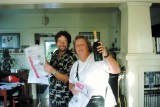
Ellen and Lyle at the home of Liz and Kent, celebrating the printing of the first issue of the Troubadour
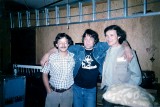
Lyle, Gene Clark, and Jim Wakefield backstage at the Belly Up, 1980s
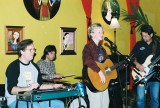
The Desert Poets w/ Kevin Ryan, Dannie Cress, Derek Duplessie and Lyle Duplessie
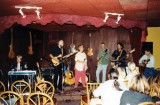
Early incarnation of the Byrds tribute band: (l to r) Derek Duplessie, Gene Rochambeau, Liz Abbott, Jim Wakefield, Lyle Duplessie, Kent Johnson
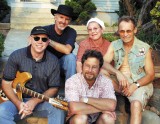
Fowl Play (l to r) Gene Rochambeau, Randy Hoffman, Lyle Duplessie, Liz Abbott, Kent Johnson
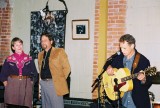
Liz, Lyle, and Kent sing Smokey Rogers’ hit “Gone” at Dizzy's, 2003
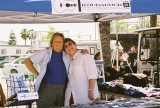
Ellen and Liz man the Troubadour booth at the 2003 Adams Avenue Roots Festival
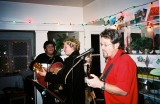
Bart Mendoza jams with Derek and Lyle at a Troubadour Christmas Party

The Scottsville Squirrel Barkers reunion, 2003
In 2001, a three-pronged attack on the East Coast — unprecedented in its scope — numbed the nation and the world. Also in that year, Bob Dylan made another strong album, Love and Theft, and continued to play around the globe on his “Never Ending Tour.” One of the top best sellers was historian David McCullough’s superb biography of President John Adams. It was during that intense year that the publication you are currently reading launched its inaugural edition: a joint September-October 2011 issue. Cowboy Jack Johnson’s tribute show to Hank Williams graced the cover.
Inside the Troubadour’s “Welcome Mat” page, publisher Lyle Duplessie presented his vision for the new publication. For anyone who had the opportunity to converse with Lyle (I did only once; I recall it being quite substantial), the word “ambiguity” didn’t exist in the man’s vocabulary. He’d let you know where he stood on a potpourri of subjects. The following excerpt was the concluding paragraph to Lyle’s vision:
“The business of music is just that: a competitive, cut-throat machine that is designed to exploit what can be sold to a mass audience. And after saturating the market with the crap until it can’t give away its product, it moves on to the next trend. Unlike the music industry, this publication is dedicated to musicians and music lovers who know the real stuff when they hear it. It is intended to facilitate the camaraderie among players, performers, and songwriters whose vision it is to make quality music, despite the trends, music that they’re proud to share with others. For long after the music industry merges, dissolves, reorganizes, and eventually self-destructs, we’ll still be out here just pickin’ and grinnin.’”
(The last sentence of Lyle’s vision paraphrases lyrics written long ago by Richie Furay. The Buffalo Springfield-Poco-Rock and Roll Hall of Fame member would no doubt have been pleased.)
Lyle was part of a Fourth Estate quartet that included his wife and Troubadour business partners Liz Abbott and Kent Johnson. Kent was the first to meet the Duplessies. “The first time Lyle and I got together and jammed on Byrds’ songs, I related how much I loved Gene Clark’s music and Lyle told me how he met Gene out in front of his (La Jolla) house on Nautilus Street,” Kent recalled in the February 2005 issue of the Troubadour. “Well, it turns out that Lyle got together with him a few times and got to know him. He even had a stack of photographs a foot high to prove it.
“That was the beginning, although we didn’t know it at the time, of a Byrds’ tribute band that included former King Biscuit Blues Band virtuoso guitarist Gene Rochambeau and drummer-percussionist extraordinaire Randy Hoffman. Lyle played bass, Liz played tambourine, I played rhythm guitar, and we all sang. We named the band, aptly, Fowl Play. We had all been such avid Byrds fans since the ’60s that it was really a special time for all of us to be able to play our favorite songs from our youth.
“Call it fate, but a few nights after the day Lyle and I first jammed together, I was at Java Joe’s when Ellen mentioned to me that she wanted to start a music publication called the San Diego Troubadour but didn’t actually know how she was going to go about making it a reality. I said, ‘Well, you’re in luck. My wife is a graphic designer and knows all about publication layout. She is also an experienced editor. I am a distribution expert, having delivered the Ken Cinema film calendars for the past 20 years.’ Her eyes lit up.
“After introducing Lyle and Ellen to Liz,” said Kent, “we talked about forming a partnership, and the San Diego Troubadour become a reality. The four of us developed a very special relationship over the next three years and the newspaper we started evolved into a valid, respectable publication.”
In the same February 2005 issue, Liz echoed the sentiments of her husband, Kent, describing the foursome as growing “more excited as the pieces of the puzzle began to come together. Ellen had already gotten print estimates, had solicited various music-oriented businesses for advertising, and rounded up people like Lou Curtiss, Paul Abbott, and Russ Bauder (aka Gus Williker) to write columns. She and Lyle would write the main stories. It sounded so homespun, it reminded me of one of those Judy Garland-Mickey Rooney movies in which they’re planning to stage a play in the barn or something and somebody pipes up, ‘My Mom can sew the costumes!’ At any rate, Ellen had done her homework. Now all she had to do was figure out how she was going to put it together and get it out there. She found her answer in Kent and me. With Lyle as head writer, Ellen’s vast network of local music connections, me as graphic designer and editor, and Kent as distribution guy and advertising salesperson, our team was complete.”
Complete — and ready to let the presses roll! With a motto below the masthead that read, “alternative country, Americana, roots, folk, gospel, and bluegrass music news,” Lyle, Ellen, Kent, and Liz provided a different coverage and perspective to the local music scene. Artists who appeared on the cover in the early years included Lisa Sanders, Berkley Hart, Sam Hinton, Chris Hillman, and one of the most successful San Diego groups to emerge from any musical genre: Nickel Creek.
The capacity to find advertisers, meet the monthly deadlines, and develop a core following did not, however, prepare the Troubadour family for a grief-stricken 2004. In that year, Ellen lost her gallant battle with breast cancer on February 24. A few months later brought an incident that mourners could express few words. Families I know personally who have gone through a similar episode use the popular American slang of the “double whammy.” On June 17, Lyle emerged from his time of grieving and enjoyed a day of surfing with loved ones, only to die on the sands of South Mission Beach from a heart attack after completing a ride. Ellen and Lyle were the parents of three music fans: daughters Megan Duplessie DeLeon and Jenna Duplessie Pabalate and son Derek Duplessie. Derek’s live shows and recordings were prominently displayed in the early years of the Troubadour.
Currently enrolled in a Ph.D program at Tulane University, Derek took time out from his studies to look back at the newspaper’s early years. “The Troubadour traces its roots back to something resembling a biblical revelation. I remember the morning that my mom sprung the crazy idea on us. It really must have occurred to her in a dream because, as far as I know, she hadn’t even considered the possibility when she went to sleep the night before. I call it a crazy idea, because this particular revelation came on the heels of a string of slightly more plausible revelations, none of which had amounted to much. There was the coffee shop that my parents founded and presided over for a whole five months, the plan to start building and selling vintage skateboards (my parents ended up selling “Retroskate” to a Japanese entrepreneur), and many other plans that never even made it off the storyboard. This new idea was no worse than the others, but even more improbable considering that neither of my parents had even an ounce of business sense or technical know-how.”
Derek continued, “Meeting Liz and Kent was really the determinative moment both for my parents and for the nascent idea. Liz had a great aesthetic vision for the paper’s layout, and actually knew how to use a computer–more than could be said for my parents–and Kent had broad and deep connections within the San Diego music scene, experience with distribution and a personality perfectly suited for rounding up advertisers. If it wasn’t for them, the first — and probably last — issue of the Troubadour would have been published on my Dad’s 30-year-old typewriter and distributed (very) locally from the back of my mom’s station wagon. Because of their limitations, my parents originally wanted to model the paper after the iconic, if homespun, Cosmic American Music newsletter, to which my Dad had been a long time subscriber. Because of Liz and Kent, the publication ended up coming to resemble a real live paper, a fact that never failed to astonish my parents. I’m proud to point out the one and only contribution that I made to the Troubadour: its name!”
Since the passing of Ellen and Lyle, the Troubadour has fulfilled the Duplessies’ vision. Liz recently mentioned that one of the newspaper’s greatest accomplishments was serving as a facilitating tool in getting the Scottsville Squirrel Barkers reunited in 2003, after not having played together since the early ’60s. The Squirrel Barkers provided an important foundation for the exploding California country rock movement of the late ’60s and early ’70s. Ed Douglas (former proprietor of the Double Eagle guitar shop in Normal Heights), Larry Murray (Hearts and Flowers), future Byrd bassist Chris Hillman, Kenny Wertz (Country Gazette), and Bernie Leadon (the Eagles) were some of the Squirrel Barkers’ famous alumni. The band’s celebrated reunion shows in Carlsbad and Normal Heights were covered in the pages of the Troubadour.
Hillman was one of the three members of the Rock and Roll Hall of Fame who have been interviewed in the Troubadour; the others were Byrds leader Roger McGuinn and John Sebastian, the most prominent member of famed Greenwich Village folk-rockers, the Lovin’ Spoonful. The results were the same; like Chris, Roger, and John came off as thoughtful artists who still carry a passionate fire for their songwriting craft. Two other major American songwriters also participated in the Troubadour’s Q&A forum: Jimmy Webb, the Oklahoma native who began writing songs in earnest as a San Bernardino college student; and Burt Bacharach, no stranger to the Del Mar community, particularly during the horse racing season. Eclectic artists were also given their space; long marching to the beats of their own drummers were former National City pizza flipper Tom Waits, postman John Prine, and Fairport Convention founding member Richard Thompson.
More often than not, cover articles were devoted to contemporary hometown talent. Songwriters have included Jason Mraz, Dave Howard, Gregory Page, and Cindy Lee Berryhill, Joe Rathburn, and Sara Petite; jazz community standouts included saxophonists Joe Marillo, Charles McPherson, Daniel Jackson, bassist Bob Magnusson and guitarist Peter Sprague.
Concept albums were records where the dozen or so tracks were connected by a common theme. Beginning with Frank Sinatra’s Only the Lonely and continuing with the Beach Boys’ Pet Sounds and the Beatles’ Sgt. Pepper’s Lonely Hearts Club Band, the concept LP advanced the art of vinyl storytelling. The Troubadour took the concept album idea to heart by creating a series of issues devoted to a theme. There was a women’s issue concentrating on San Diego females who were performing or were involved in the business side of music, and several Celtic editions which always seemed to fall around March 17th. “How to” editions were designed for the aspiring musician, such as “The New Station for Future Radio,” “Where to Begin and how to Excel in the Scene: a guide to the local music industry,” Knocking on a Million Doors,” and “Conversations with San Diego’s Emerging Artists” were the titles of some of the articles.
It there is one staff member who is a true troubadour, it is Lou Curtiss. In his monthly column, “Recordially,” Lou takes readers down the roads of his youth (witnessing the legendary “Town Hall Party” television shows in Los Angeles, hunting for rare 78 rpm records in the rural south, soaking in the Greenwich Village atmosphere in the ’60s), and his current projects (foremost among them, continued funding for the digitization of his massive archives). If you have not tuned into his Sunday night “Jazz Roots” radio show on Jazz 88.3 or joined in his musical jam sessions or visited his record store (Folk Arts Rare Records) in Normal Heights, you should find time to do so. We at the Troubadour are fortunate to have him as a fellow writer and a mentor who makes sure we get our facts straight — and he certainly is not afraid to tell us when we don’t! Along with Lou, the other columnist from the premier issue who is meeting his monthly deadlines is free spirit Jose Sinatra. Over the decade, other columnists have been added to the roster: Dwight Worden’s “Bluegrass Corner,” Sven-Erik Seaholm’s “The Zen of Recording,” Jim Mcinnes’ “Radio Daze,” and Southwestern College Professor-Coyote Problem front man Peter Bolland’s “Stages,” a column devoted to “Philosophy, Art, Culture and Music.”
Although much of the Troubadour’s coverage is devoted to traditional American music, the publication itself is not averse to technological advancement. In 2004 the San Diego Troubadour went on line, with webmaster Will Edwards putting together a site embraced by a global audience. Last January, the Troubadour began delivering podcasts of the cover artists. Interviews were recorded in the home studios of Jeff Berkley. Gaslamp Quarter’s pioneering entrepreneur Ingrid Croce was the first artist to sit in the interviewee’s chair.
On the surface, the upcoming gala at the Sunset Temple to celebrate our tenth anniversary may seem an elaborate form of the publication patting itself on the back. Fair enough. But there is a larger mission at stake. This is a fundraiser as well as a celebration. This will be an opportunity for the newspaper to bring in greater advertising revenue (the life blood of any paper, trust me), to improve the website design, and to increase circulation.
In the pre-party strategy meetings at some local watering holes, Liz, myself, Michael Rennie, and Pete Bayard discussed the fund-raising element of the gala. I believe it was Michael who provided a satisfying explanation when Liz posed this question;. “Who is our target audience to help us in our fund raising?” Michael provided the following criteria:
1. If you an artist who has ever appeared on the cover of the Troubadour or have been featured on the inside pages.
2. If you are an artist who has benefited from a CD review in the Troubadour.
3. Â Â Â If you are a regular Troubadour reader who has looked forward to the free monthly publication appearing in a branch library or local coffee house.
4. If you are a music fan who has attended a concert listed in the calendar section or featured on the “Local Seen” photo page.
I didn’t major in statistics in college, but suffice to say, we are talking about a lot of people. And we hope to see many of you on October 9th.
The San Diego Troubadour 10th Anniversary Celebration and Fundraiser will take place Sunday, October 9, 6-11pm at Sunset Temple, 3911 Kansas Street behind Claire de lune in North Park. This fun-filled evening will feature Berkley Hart, Steve Poltz, A.J. Croce, Robin Henkel, and Peter Sprague and Leonard Patton as headliners alongside the traditional Troubadour Open Mic at which anyone can get up and play by signing up at the party. An Opportunity Drawing to win a Taylor SolidBody Guitar or a Deering Goodtime Banjo. Tickets for the drawing are still available for purchase at Classic Bows Violin Shop, New Expression Music, Moze Guitars, the Blue Guitar, and Buffalo Brothers. There will also be a silent auction that features dinner and wine for 10, plus a wine tasting. In addition, Troubadour 10th Anniversary t-shirts will be available for purchase as will a Troubadour 10th Anniversary Compilation CD, featuring various cover artists from the past 10 years. For further information and to buy tickets for general admission or VIP Seating (includes a table in front of the stage, plus two drink tickets and two opportunity drawing tickets, go to https://sandiegotroubadour.com/10th-anniversary-celebration/
Steve Thorn is an adjunct history instructor in San Diego. His first record review was Rod Stewart’s Every Picture Tells a Story, which appeared in a 1971 issue of the Grossmont High School student newspaper, The Foothill Echoes.






